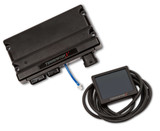Fox vs. SN95: Picking a Car for Your Small Block Build Fox Body SN95
Whether you’re looking for an inexpensive Mustang project car or a full race machine, your build will probably start with one question: Should you get a Fox body or an SN95? Both cars share similar underpinnings, so it may be tempting to choose based on styling. However, there’s a lot more that separates these generations than just looks.
Fox Body
Ford introduced this replacement for the popular but decidedly non-sporty
Mustang II in 1979. Based heavily on the platform developed for the inexpensive
Fairmont, its rack and pinion steering and four link rear suspension were
innovative at the time, but haven’t aged well. Aside from a few bright spots
like the SVO, the predecessor to the modern Cobra, performance was lacking due
to a combination of emissions requirements, high gas prices and lack of
development funds.
That started to change in 1986 with the introduction of better fuel injection
systems, changes to the V8’s head and piston design, and the switch from the
7.5 rear end to the 8.8. The Fox body had finally moved past being a dressed-up
Fairmont, and in the process was delivering performance that would have been
respectable during the muscle car era with plenty of room to grow.
SN95
The Probe was expected to replace the Mustang, giving buyers a high MPG sports
car, but a combination of a high price tag, lower fuel prices, heavy demand for
the revised Fox body and a massive letter writing campaign from fans made it
clear that there was still a market for a traditional rear wheel drive,
V8-powered pony car.
Ford made the decision to keep the Mustang in 1989, spending over 700 million
dollars to update the Fox platform. While the basic structure stayed the same,
almost every part was modified: the car had a wider track, the front end got
longer control arms, disc brakes were used on all four wheels, anti-lock brakes
were an option and 5 lug hubs became standard. A V6 replaced the underpowered
four cylinder, and a new cockpit-style interior gave the car a more upscale
feel.
The car debuted in 1994 with the 5.0, which was replaced in 1996 with the new
4.6 liter OHC “Mod” motor. It had the same horsepower and torque ratings, but
lacked low-end grunt and had little in the way of aftermarket support. It took
a few years to tap into the new motor’s potential, taking advantage of a strong
bottom end by improving head flow, first with units from Trick Flow, then with
Ford’s own Performance Improvement (P.I.) design. The “New Edge” redesign in
1999 changed the exterior while leaving the inside and mechanicals intact.
Which One is Better?
Like most comparisons, the answer is “it depends.” The SN95 and Fox are
essentially the same car underneath and the same basic methods for increasing performance
work for both cars, but they have different starting and ending points.
Thanks to Ford’s continued development, an SN95 is a better performance
proposition in stock form. It already has better brakes and more wheel and tire
options thanks to the 5 lug hubs, two modifications that are usually at the top
of a new Fox body owner’s to-do list. Interior improvements also make it a more
comfortable daily driver. Finding a 94-95 model is the easiest place to start
for a small block build, but any model can use these engines once the right
K-member is installed.
On average, the Fox is around 200 lbs. lighter than an SN95, although actual
differences can vary 50 lbs. either way depending on equipment and body styles.
For a nearly stock car, that’s probably not enough to make a pricier Fox worth
buying over the later Mustang. However, once planned modifications move past a
few bolt-ons, the SN95 loses its advantage over this older mode. Want to
strengthen and lighten the front end with a new K-member? There are models
available that will work with a Mod motor or Coyote. Want bigger brakes? The
same components are needed to fit them on either model. While the engine bay is
a little more cramped, the lack of dual airbags and other components makes
stripping out the car easier, and that small 200 lb. difference starts to look
bigger after trimming off some weight with lighter components.
Which one should you buy?
If you’re looking to build an inexpensive daily driver that can
be used for occasional track or drag strip use, you may want to start with an
SN95. If you’re going to replace many of the stock components anyway, the Fox’s
weight advantage comes into play, while the SN95’s equipment advantages become
negligible.
Start Your Build with Help from Anderson
Ford Motorsport
No matter what you choose for your project, Anderson Ford Motorsport can help
you build the Mustang of your dreams. We’ve been working on these cars since
Fox bodies were rolling out of the factory, helping us recommend Ford
Mustang parts that
work for cars built for everything from weekend cruises to racing.
Recent Posts
-
Bringing the Fox Body Mustang into the 21st Century with Holley Terminator X
Anderson Ford Motorsport has been in the Fox Mustang performance industry since 1989. One of the bi …22nd Oct 2021 -
Roush Supercharger install on a 2019 Ford Mustang
Check out this 2019 Ford Mustang before and after we installed a Roush Supercharger. …21st Feb 2020 -
All Blower Installations are not Equal.
Why Should You Choose a Company to Install Your Blower That Has a Dyno Facility In-House?Are all de …24th Jan 2020

